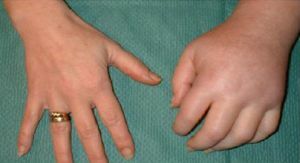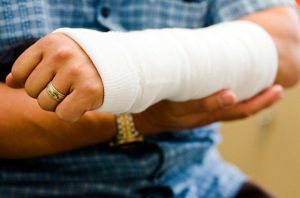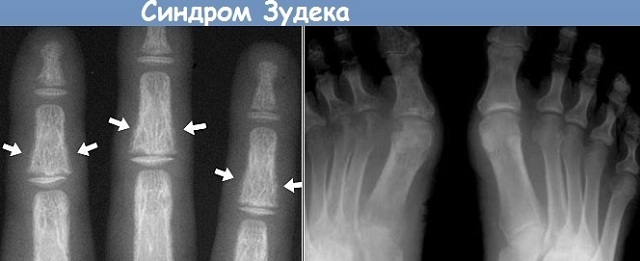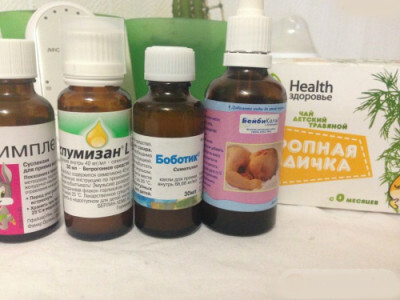 Syndrome Zudeka( Morbus Sudeck) is also called atrophy or algoneurodystrophy.
Syndrome Zudeka( Morbus Sudeck) is also called atrophy or algoneurodystrophy.
This disease refers to the pain that develops as a result of trauma to the upper limbs. Occasionally occurs when overexertion.
Contents
- Historical digest
- Pathogenesis and causes of the disease
- Pathogenesis
- Etiology
- Stage classification
- Symptoms of the disease
- Diagnostic criteria
- Medical care
- Preventive measures
Historical digest
P.H.M.Sudeck, a surgeon from Germany, in 1900 studied the typical X-ray patterns, characteristic of a number of inflammatory bone and joint diseases, characterized by the rapidity of bone atrophy.
Zudek gave this phenomenon the name of acute trophoneurotic bone atrophy. It, according to the surgeon, was the reason for the violation of the vegetative functions of the local order. In addition to the German doctor, this phenomenon was later described and studied by the surgical doctor R. Lerish( France).
The International Association for the Study of Pain in 1996 adopted the Zudek syndrome and the order of similar terms - causalgia, posttraumatic dystrophy, hand-shoulder syndrome, reflex sympathetic dystrophy, substitute for CRPS( complex regional pain syndrome, CRPS).
The pathogenesis and causes of the disease
The main causes of the occurrence of CRPS syndrome: 
- injured bone experienced severe stress, pressure;
- squeezed damaged tissues when the dressing was incorrectly applied;
- scars that inhibit correct circulation;
- psychological component - the syndrome often occurs in people suffering from a number of phobias.
Pathogenesis of
Because of disturbed vascular and nervous regulation, there is local dysfunction of metabolism, markedly manifested inflammation of soft tissues and bones of the injured limb. In turn, this causes irritation of the nociceptive axons - a "vicious circle" is obtained.
The place of defeat, in the first place, is the brush, the forearm area, less often - the foot and the shin. The average age of patients is 40-60 years.
The syndrome begins to develop between one day and two months after the injury. At the same time, the degree of its severity hardly affects the severity of the course of neurodystrophy.
Etiology
Most often reflex sympathetic dystrophy takes place when there is incorrect treatment after fracture of the arm radial and( or) lack of rehabilitation skills in case of trauma, improper limb immobilization.
Also, the formation of a neurodystrophic syndrome is accompanied by painful procedures in patient therapy, poor-quality dressings, the assumption of the likelihood of edema, premature activity after trauma.
Very high probability of manifestation of the syndrome during hot medical procedures, rough massage, sudden movements.
Classification of stages
Development of Zudeck's syndrome includes three stages:
- Inflammation of - painful changes and impaired functions( 0-3 months).
- Dystrophy - the onset of pathological changes of morphological type( 3-12 months).At this stage, it is still possible to restore limb function.
- Atrophy of - the process comes to total loss of motion functions. At this stage, the degenerative processes of transformation are irreversible.
Symptoms of the disease
The occurrence of certain symptoms, among other things, indicates the stage of development of the Zudeck syndrome in the patient: 
- "Red" - redness of the skin;there are painful sensations at influence of a cold, at disturbance of a state of rest( "deep", acute);nocturnal soreness;articular mobility is narrow;edema of the test form, smoothing the folds of the skin;the skin itself is glossy and warm to the touch;rapid growth of nails;hypertrichosis;hyperhidrosis.
- "Blue" - unlike the first stage in this case, the skin, on the contrary, is pale and cool, but also shiny;loss of joint mobility;the onset of atrophy and fibrosis;soft tissues begin to wrinkle.
- "White" - skin integument tense, cyanotic: limb is not functioning - a consequence of muscle and joint atrophy;wrinkling of tendons and soft tissues;absence of pain;dependence of exacerbations on weather.
For all stages of development of neurodystrophy, movement, sensory and autonomic functions are characterized.
Diagnostic criteria
For the purpose of clinical examination, the temperature of the affected and healthy limb is measured and then compared, thermography, ninhydrinolysis( for sweating).
Radiography in phases:
- No changes are observed in the first half-month, then separate spots of discrete demineralization of spongiosis in the immediate vicinity of the joint.
- Progression of demineralization, destruction of the cortical layer.
- "Glass bone" - osteopenia, thinning of the cortical layer. It is recommended that CT or MRI be performed.
Scintigraphy in a three-phase technique is recommended in the first stage.
Differential diagnosis is necessary with the following diseases and disorders: immobilization osteopenia, as a cause of pain after injury to the limb, as well as inflammatory processes in the soft and articular tissues, tumors, arthrosis, bone necrosis, crystal arthropathy, fractures caused by overexertion.

In the photo, a typical picture observed on the X-ray at the
Syndrome Medical Assistance The
Therapies basically respond to the first two stages of the disease. Therefore, it is important to go on time for help to a neurologist or traumatologist. The treatment of the Zudeck syndrome is mainly carried out in a conservative manner, in the prevalent number of cases without surgery.
Therapy begins with the establishment of an accurate diagnosis and determination of the stage of the disease.
First of all, potent analgesics are prescribed - Analgin, Bral, Diclofenac, Ketanov, Ketorol, tk.the patient with the disease experiences intense pain even with the slightest movement. It is also assumed immobilization of the limb for two weeks, giving it an elevated position, applying cold.
Against algoneurodystrophy, they fight with vasodilators, muscle relaxants, vitamins of class B. Physiotherapy is actively used:
- laser therapy;
- acupuncture;
- cryotherapy;
- ultrasound;
- interference procedures;
- massage;
- exercise therapy.
It should be noted that these techniques are not desirable in the "acute" period of CRPS, but are applied only at the stage of recovery. Sometimes a patient needs psychological help and the appointment of antidepressants, antipsychotics.
 At the last stage, characterized by the progression of osteoporosis, the goal of treatment is to slow down and stop bone destruction with drugs containing magnesium, calcium and other minerals.
At the last stage, characterized by the progression of osteoporosis, the goal of treatment is to slow down and stop bone destruction with drugs containing magnesium, calcium and other minerals.
Surgical intervention is resorted only when all of the above methods have not brought any benefit.
The duration of treatment is directly affected by the stage of the syndrome, the age of the patient, the degree of neglect of the condition. On average, it takes from 6 to 12 months.
A useful set of exercises that will help you recover from a broken arm quickly and painlessly:
Preventive measures
Alas, there are no effective preventive measures.
Attention is recommended to repeated injuries, adherence to the recommended deadline for fixing a damaged limb, the use of physiotherapy in the early stages, a low level of workload. When diagnosing typical symptoms of neurodystrophy, it is necessary to consult a specialist as soon as possible.
During the rehabilitation period the patient should avoid intensive thermal procedures, rough massage.
It is best to conduct a sanatorium and health resort with the adoption of radon baths, therapeutic gymnastics, gravity therapy.
 At the last stage, characterized by the progression of osteoporosis, the goal of treatment is to slow down and stop bone destruction with drugs containing magnesium, calcium and other minerals.
At the last stage, characterized by the progression of osteoporosis, the goal of treatment is to slow down and stop bone destruction with drugs containing magnesium, calcium and other minerals. 


